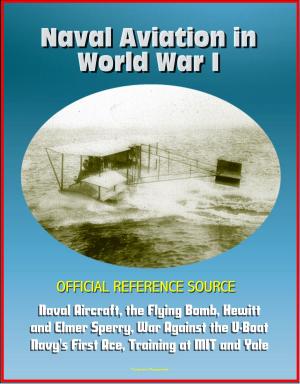The Better Blitzkrieg: A Comparison of Tactical Airpower Use by Guderian and Patton, Luftwaffe, Panzer Campaign, Close Cooperation at the Meuse, German and Army Air Forces Airpower Doctrine
Nonfiction, History, Military, Aviation, World War II| Author: | Progressive Management | ISBN: | 9781370229598 |
| Publisher: | Progressive Management | Publication: | September 28, 2016 |
| Imprint: | Smashwords Edition | Language: | English |
| Author: | Progressive Management |
| ISBN: | 9781370229598 |
| Publisher: | Progressive Management |
| Publication: | September 28, 2016 |
| Imprint: | Smashwords Edition |
| Language: | English |
This important report has been professionally converted for accurate flowing-text e-book format reproduction. Historians have debated for decades the reasons for the spectacular failure of the Luftwaffe during the last three years of World War II. As the Luftwaffe went down in flames, the United States Army Air Forces arose to conquer the airspace on the Western Front of Europe. Before its downfall, Luftwaffe tactical airpower was key to Gen Heinz Guderian's surprise attack through the Ardennes to the English Channel in 1940. Similarly, in 1944, as Gen George S. Patton broke out of the Normandy beachhead by unleashing Operation Cobra, tactical airpower proved vital to his ability to march to the German border in only six weeks. This paper analyzes a host of primary sources authored by the main players in those campaigns (Guderian, Patton, and Weyland) and focuses on the key differences between the Luftwaffe support to Guderian and XIX Tactical Air Command support to Patton during their historic campaigns on the Western Front of Europe in World War II.
Few military forces in history have seen such a remarkable turnaround in fortunes as the Luftwaffe experienced in World War II. From its early successes in the Spanish civil war, where the Luftwaffe cut its teeth and gained valuable combat experience, to Stukas firing the first shots of World War II in Poland, the might of the Luftwaffe, like all of Nazi Germany, seemed invincible. Never was the Luftwaffe a more capable fighting force than during General Guderian's rout of the French army as he charged through the Ardennes to the English Channel. But during Guderian's race across France and the Low Countries, problems in coordination and cooperation between the Luftwaffe and the German army arose. These deep-seated problems, the result of the Luftwaffe's strategic vision of its role in the Wehrmacht, meant that even the vaunted Luftwaffe remained essentially an interdiction only air force, devoid of the ability to perform close support to German armies. In the end, overwhelming force led to the eventual defeat of the Luftwaffe at the hands of both the US Army Air Force (USAAF) and the Soviet Air Force. Yet the lessons the Luftwaffe learned during Guderian's drive across Europe are applicable not only for the 1940s USAAF but to today's Air Force as well.
As the Luftwaffe declined under the sheer weight of the Allied offensives in the west and east, the USAAF arose as the world's finest air combat force. From early missteps in Africa and Italy, the USAAF fighter-bombers mastered close support and interdiction, and, in the process, they became a stanchion of the breakout from the Normandy beachhead and the race to Germany. Indeed, never had the world seen such a fierce and efficient AirLand Battle team. Working in close concert with ground forces, USAAF fighter-bombers waged incessant interdiction and close-support operations against the Wehrmacht, paving the way for Patton's Third Army and others to march to Germany faster than even the most liberal estimates. Both Guderian's drive through France in 1940 and Patton's drive to Germany in 1944 embody the prevailing attitudes and strategy towards the use of tactical airpower by the Luftwaffe and the USAAF. But, while the USAAF overcame doctrinal limitations and capitalized on tactical airpower in the nascent AirLand Battle team, the Luftwaffe remained mired in old strategy, relegating the Wehrmacht airpower to an interdiction only force.
This important report has been professionally converted for accurate flowing-text e-book format reproduction. Historians have debated for decades the reasons for the spectacular failure of the Luftwaffe during the last three years of World War II. As the Luftwaffe went down in flames, the United States Army Air Forces arose to conquer the airspace on the Western Front of Europe. Before its downfall, Luftwaffe tactical airpower was key to Gen Heinz Guderian's surprise attack through the Ardennes to the English Channel in 1940. Similarly, in 1944, as Gen George S. Patton broke out of the Normandy beachhead by unleashing Operation Cobra, tactical airpower proved vital to his ability to march to the German border in only six weeks. This paper analyzes a host of primary sources authored by the main players in those campaigns (Guderian, Patton, and Weyland) and focuses on the key differences between the Luftwaffe support to Guderian and XIX Tactical Air Command support to Patton during their historic campaigns on the Western Front of Europe in World War II.
Few military forces in history have seen such a remarkable turnaround in fortunes as the Luftwaffe experienced in World War II. From its early successes in the Spanish civil war, where the Luftwaffe cut its teeth and gained valuable combat experience, to Stukas firing the first shots of World War II in Poland, the might of the Luftwaffe, like all of Nazi Germany, seemed invincible. Never was the Luftwaffe a more capable fighting force than during General Guderian's rout of the French army as he charged through the Ardennes to the English Channel. But during Guderian's race across France and the Low Countries, problems in coordination and cooperation between the Luftwaffe and the German army arose. These deep-seated problems, the result of the Luftwaffe's strategic vision of its role in the Wehrmacht, meant that even the vaunted Luftwaffe remained essentially an interdiction only air force, devoid of the ability to perform close support to German armies. In the end, overwhelming force led to the eventual defeat of the Luftwaffe at the hands of both the US Army Air Force (USAAF) and the Soviet Air Force. Yet the lessons the Luftwaffe learned during Guderian's drive across Europe are applicable not only for the 1940s USAAF but to today's Air Force as well.
As the Luftwaffe declined under the sheer weight of the Allied offensives in the west and east, the USAAF arose as the world's finest air combat force. From early missteps in Africa and Italy, the USAAF fighter-bombers mastered close support and interdiction, and, in the process, they became a stanchion of the breakout from the Normandy beachhead and the race to Germany. Indeed, never had the world seen such a fierce and efficient AirLand Battle team. Working in close concert with ground forces, USAAF fighter-bombers waged incessant interdiction and close-support operations against the Wehrmacht, paving the way for Patton's Third Army and others to march to Germany faster than even the most liberal estimates. Both Guderian's drive through France in 1940 and Patton's drive to Germany in 1944 embody the prevailing attitudes and strategy towards the use of tactical airpower by the Luftwaffe and the USAAF. But, while the USAAF overcame doctrinal limitations and capitalized on tactical airpower in the nascent AirLand Battle team, the Luftwaffe remained mired in old strategy, relegating the Wehrmacht airpower to an interdiction only force.















